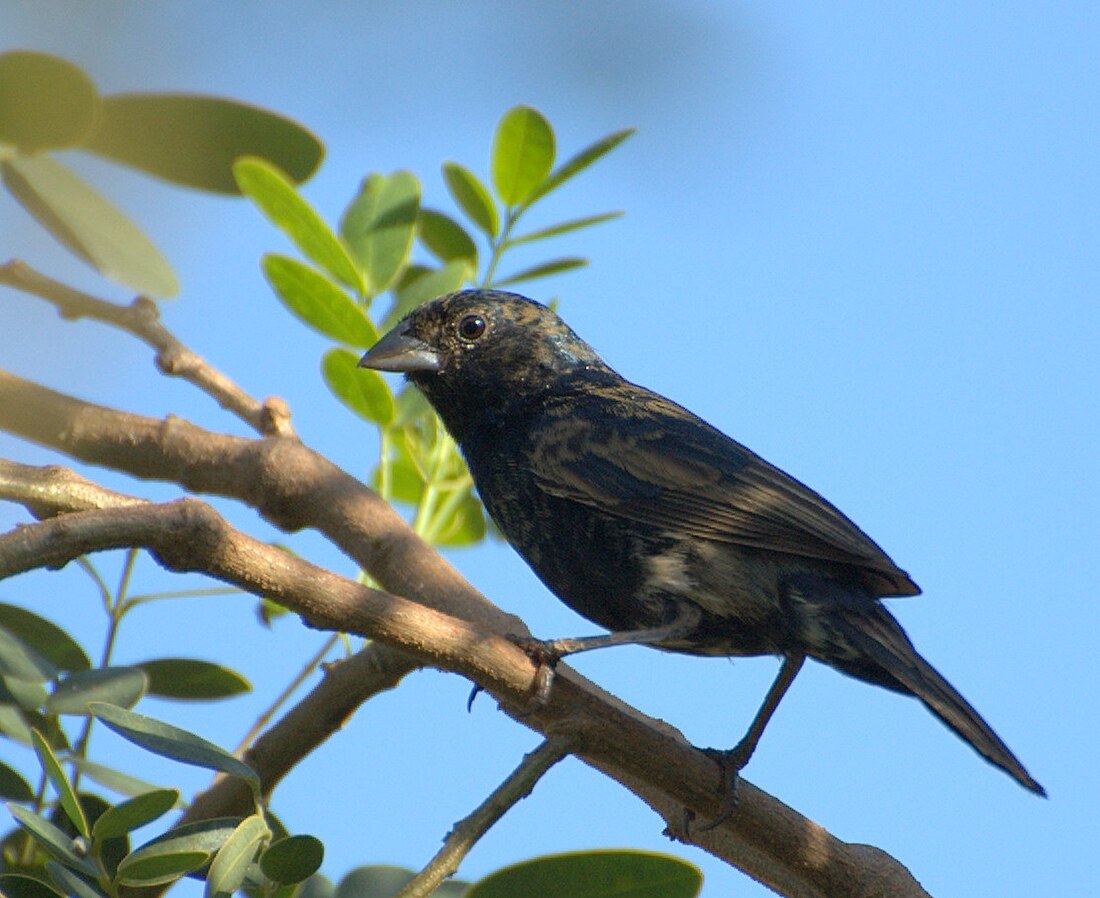Blue-black grassquit
Species of bird From Wikipedia, the free encyclopedia
The blue-black grassquit (Volatinia jacarina) is a small Neotropical bird in the tanager family, Thraupidae. It is the only member of the genus Volatinia. It is a common and widespread bird that breeds from southern Mexico through Central America, and South America as far as northern Chile, Argentina, and Paraguay, and in Trinidad and Tobago.[2] A male was also observed in Graham County, Arizona on July 15 and July 17, 2023.[3]
| Blue-black grassquit | |
|---|---|
 | |
| male at Manduri, São Paulo State, Brazil | |
 | |
| female at Manduri, São Paulo State, Brazil | |
| Scientific classification | |
| Domain: | Eukaryota |
| Kingdom: | Animalia |
| Phylum: | Chordata |
| Class: | Aves |
| Order: | Passeriformes |
| Family: | Thraupidae |
| Genus: | Volatinia Reichenbach, 1850 |
| Species: | V. jacarina |
| Binomial name | |
| Volatinia jacarina (Linnaeus, 1766) | |
 | |
| Synonyms | |
|
Tanagra jacarina Linnaeus, 1766 | |
This species is sexually dimorphic; the male is glossy blue with some white under the wing. The female is brown above and pale buff with darker streaks below.
Taxonomy
Summarize
Perspective
The blue-black grassquit was described by the Swedish naturalist Carl Linnaeus in 1766 in the twelfth edition of his Systema Naturae under the binomial name Tanagra jacarina.[4] Linnaeus based his description on the "Jacarni" that was described in 1648 by the German naturalist Georg Marcgrave in his Historia Naturalis Brasiliae.[5][6] The type locality is eastern Brazil.[6] The specific epithet jacarina is derived from the Tupi language and was used for a type of finch.[7] The blue-black grassquit is now the only species placed in the genus Volatinia and was introduced in 1850 by the German naturalist Ludwig Reichenbach.[8][9] The genus name is a diminutive of the Latin volatus meaning "flying".[10]
Within the tanager family Thraupidae the blue-black grassquit is in the subfamily Tachyphoninae and is a member of a clade that contains the genera Conothraupis and Creurgops.[11][12]
The blue-black grassquit was formerly placed with the buntings in the subfamily Emberizinae rather than with the tanagers in Thraupinae within an expanded family Emberizidae.[6][11]
Three subspecies are recognised:[9]
- V. j. splendens (Vieillot, 1817) – Mexico to Colombia and east through Venezuela and the Guianas to the Amazon basin; also Trinidad, Tobago and Grenada
- V. j. jacarina (Linnaeus, 1766) – southeast Peru to east Brazil and south to north Argentina
- V. j. peruviensis (Peale, 1849) – west Ecuador, west Peru, and northwest Chile
Description
Adult blue-black grassquits are 10.2 cm (4.0 in) long and weigh 9.3 g (0.33 oz). They have a slender conical black bill. The male is glossy blue-black, with a black tail and wings; the white inner underwing is visible in flight or display. Female and immature birds have brown upperparts and dark-streaked buff underparts.
Behavior
Social monogamous, extra-pair fertilizations, intraspecific parasitism, and quasi-parasitism are commonly found.[13][14] During the breeding season, males defend small territories, about 13,0 - 72,5 m2, dominant males are normally lighter.[15] The male has a jumping display, often performed for long periods, which gives rise to the local name "johnny jump-up". This is accompanied by a persistent wheezing jweeee call,[16] jumping several times in a minute.[17] The extravagant display also has a cost of calling attention of the predator, thus displaying increased nest predation.[18] Predation is the main cause of breeding failure,[19] and predator vocalizations can cause an immune-related reaction to this species.[20] Nests are small cups of rootlets (diameter about 7.5 cm) found in herbaceous vegetation 10–50 cm high,[21] clustered at a landscape,[22] and placed preferably at high complex habitat spots.[23] Nests are built by both sexes.[19][24]
Blue-black grassquits will often form flocks when not breeding. They eat seeds, mostly on the ground.[25]
References
External links
Wikiwand - on
Seamless Wikipedia browsing. On steroids.

